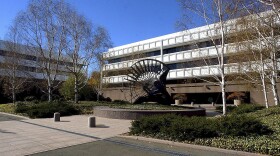This summer GE will move its corporate headquarters to Boston from Fairfield, where it’s been since 1974. But GE’s presence in Connecticut goes back almost 100 years. When GE bought one of its first factories in Connecticut in 1920, it wasn’t because of taxes or quality of life. It was because of the Russian Revolution.
When the Bolsheviks overthrew the Tsar of Russia in 1917, they canceled the arms contracts he held with the weapons maker Remington, who had a factory in Bridgeport. Remington sold the factory, and GE bought it. For decades, it built appliances like electric fans, irons and toasters.
This factory spread for 76 acres. That’s about 58 football fields. At its peak, it employed thousands of workers. It even had its own bowling alley.
“Pictures from long ago show us lines of employees along the sidewalk coming in or out of work. It was a busy, busy place back then. You would have been in, like, a city in that building,” said Adrienne Saint-Pierre, curator of Bridgeport’s Barnum Museum.
The only thing that remains of the factory today is a wrought-iron gate flanked by two brick guard houses and a short stretch of wall. Behind that gate is a 76-acre vacant lot that used to be the factory.
“It’s a very stark landscape, littered with broken brick and rubble and the odd plant that has sprung up there,” Saint-Pierre said. “It’s quite a difference between what it used to be.”
The factory may have been huge, but it wasn’t GE’s headquarters. Those were in upstate New York, where Thomas Edison founded the company in 1878. Later the headquarters moved to New York City. Then, in the 1970s, it came to Fairfield, Connecticut, just one town over from Bridgeport.
Fred Carstensen, an economist at the University of Connecticut, said GE moved to Fairfield at a time when crime was on the rise in New York City.
“You know, it went through a long period when it was not an attractive place to be, and it turned out being in Fairfield would reduce commuter times because so many of their executives already lived in Connecticut,” he said. “So it was kind of a natural choice.”
Carstensen said GE never had a close relationship with the state of Connecticut, and he’s not surprised about the decision to leave. Last year the company said it was unhappy with tax proposals in the Connecticut legislature. In a statement announcing the headquarters would move to Boston, GE’s CEO Jeff Immelt said the city has a technologically fluent workforce. He also said it offers easy access to transportation through the city’s Logan Airport.
GE’s Bridgeport factory closed in 2008, and it was torn down four years ago. Saint-Pierre said now that GE leaves for Boston, it’s bittersweet to look at the former site of the factory. She said she loves to study Connecticut’s long industrial history, and GE has played a central role in that history.
“It’s sad, though, to think that they will be no more here,” she said. “People were very sad to see this facility go down, and now with the headquarters leaving, that’s, you know, a nail in the coffin there.”
GE will still have facilities across Connecticut that include Stamford, Norwalk and Plainville. Immelt said no matter what, GE will always have some kind of presence in Connecticut.






